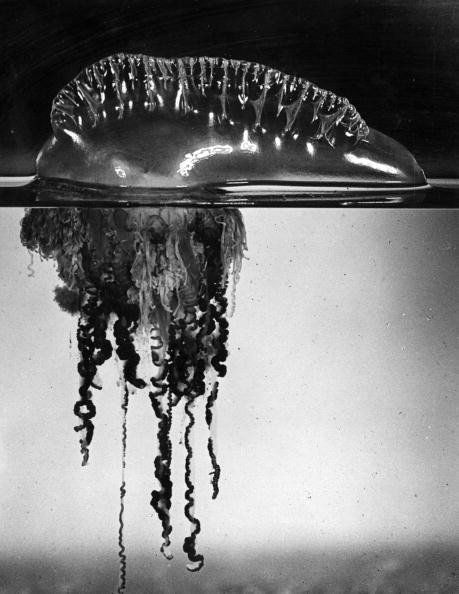Jersey Shore Nightmare: Portuguese Man-of-War; 5 Facts About This Venomous Creature
| KJ Belonio | | Jul 02, 2015 10:34 AM EDT |
(Photo : Getty Images/Douglas P. Wilson) Poisonous critters known as the Portuguese Man-of-War, which are related to jellyfish, have come ashore the East Coast beaches.
What a summertime nightmare! A venomous creature has descended upon the Jersey Shore in increasing numbers. These poisonous critters known as the Portuguese Man-of-War, which are related to jellyfish, have come ashore the island and sparked anxiety among its residents.
Like Us on Facebook
The first reported sighting of these venomous Portuguese Man-of-War was documented on June 21 in Harvey Cedars on Long Beach Island. However, more sightings were recently reported in Ocean, Cape May counties and Surf City, where more than two dozen jellyfish-like creatures were found on Saturday, NYC Today revealed.
As more stinging critters are found elsewhere on the island, experts say there's no need for local residents to panic yet. So, to give our avid readers some information, here are 5 need-to-know facts about these poisonous Portuguese Man-of-War creatures.
1. Despite its outward appearance resembling a jellyfish, they're actually not. According to New Jersey Department of Environmental Protection's Office of Science Gary Buchanan, Portuguese-or-War creatures are not true jellyfish, NJ.com reported. They are siphonophores, which are not single multicellular organisms but a colony of specialized minute individuals called zooids. Zooids are physiologically integrated to one another to the extent that they are incapable of independent survival.
2. Its name, Portuguese Man-of-War (Physalia physalis) comes from an 18th-century armed sailing ship because of its resemblance to the Portuguese version at full sail. In addition, these creatures are also called "floating terror," "blue bubble" or "bluebottle."
3. The Portuguese Man-of-War, a marine cnidarian of the family Physaliidae, has stinging cells that are still active and capable of stinging even after they're dead, New Jersey's Montclair State University associate biology professor Paul Bologna said. The creature's venomous tentacles, which can deliver a painful sting, typically extend about 8 feet (2.4 meters) under the surface of the water. It can also grow to be much longer up to 165 feet (50 meters), as per National Geographic Society.
4. Portuguese Man-of-War creatures are like "mouse traps" - if you don't touch them, they won't hurt you. But if you are so unlucky enough to get stung by them, never pee on it. While peeing on a jellyfish sting makes the stinging sensation go away, a 2011 study conducted at the Straub Clinic & Hospital in Honolulu found that urine might actually make jellyfish (or man-of-war) stings worse, Live Science noted.
Instead of using urine, experts say rinsing with fresh water as well as vinegar and other acidic compounds may help the pain of a sting. And in removing tentacles that remain on the skin, they warn not use your bare hands.
5. As East Coast beaches became the unfortunate destination of the Portuguese Man-of-War, an infestation of these jelly-monsters can be fatal. As explained by Stockton University's Marine Science professor Matthew Landau, the sting of these strange creatures can be fatal to humans.
"Symptoms are usually localized (pain where contact was made), but in some cases there can be muscle and joint aches, or even confusion and respiratory distress," Landau told Perez Hilton. "In extreme cases, a victim may go into shock, which in deep water will lead to drowning."
So, how did these Portuguese Man-of-War wind up in Jersey Shore? Buchanan said it's just a short-lived event. Since these critters are found in tropical and subtropical waters, some of them probably got blown into the Gulf Stream and moved up the coast towards New Jersey.
©2015 Chinatopix All rights reserved. Do not reproduce without permission
EDITOR'S PICKS
-

Did the Trump administration just announce plans for a trade war with ‘hostile’ China and Russia?
-

US Senate passes Taiwan travel bill slammed by China
-

As Yan Sihong’s family grieves, here are other Chinese students who went missing abroad. Some have never been found
-

Beijing blasts Western critics who ‘smear China’ with the term sharp power
-

China Envoy Seeks to Defuse Tensions With U.S. as a Trade War Brews
-

Singapore's Deputy PM Provides Bitcoin Vote of Confidence Amid China's Blanket Bans
-

China warns investors over risks in overseas virtual currency trading
-

Chinese government most trustworthy: survey
-

Kashima Antlers On Course For Back-To-Back Titles
MOST POPULAR
LATEST NEWS
Zhou Yongkang: China's Former Security Chief Sentenced to Life in Prison

China's former Chief of the Ministry of Public Security, Zhou Yongkang, has been given a life sentence after he was found guilty of abusing his office, bribery and deliberately ... Full Article
TRENDING STORY

China Pork Prices Expected to Stabilize As The Supplies Recover

Elephone P9000 Smartphone is now on Sale on Amazon India

There's a Big Chance Cliffhangers Won't Still Be Resolved When Grey's Anatomy Season 13 Returns

Supreme Court Ruled on Samsung vs Apple Dispute for Patent Infringement

Microsoft Surface Pro 5 Rumors and Release Date: What is the Latest?










